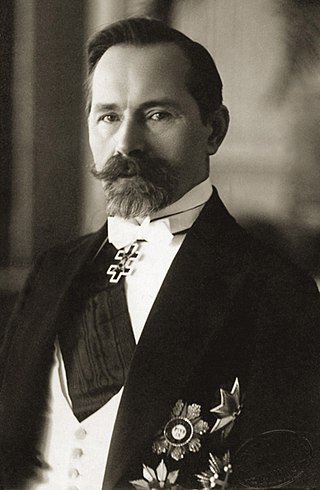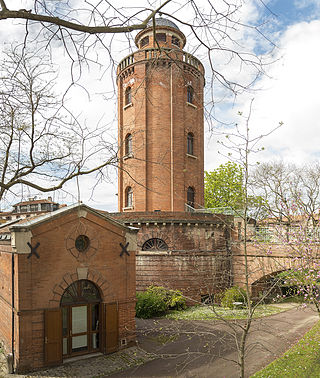
The coat of arms of Lithuania is a mounted armoured knight holding a sword and shield, known as Vytis. Since the early 15th century, it has been Lithuania's official coat of arms and is one of the oldest European coats of arms. It is also known by other names in various languages, such as Waykimas, Pagaunė in the Lithuanian language or as Pogonia, Pogoń, Пагоня in the Polish, and Belarusian languages. Vytis is translatable as Chase, Pursuer, Knight or Horseman, similar to the Slavic vityaz. Historically – raitas senovės karžygys or in heraldry – raitas valdovas.

The Columns of Gediminas or Pillars of Gediminas are one of the earliest symbols of Lithuania and its historical coats of arms. They were used in the Grand Duchy of Lithuania, initially as a rulers' personal insignia, a state symbol, and later as a part of heraldic signs of leading aristocracy.

The Lithuanian Wars of Independence, also known as the Freedom Struggles, refer to three wars Lithuania fought defending its independence at the end of World War I: with Bolshevik forces, Bermontians, and Poland. The wars delayed international recognition of independent Lithuania and the formation of civil institutions.

Stanislovas Žvirgždas is a Lithuanian photographer, particularly of landscapes, and a photography historian.
The Dr. Erich Salomon Award (Dr.-Erich-Salomon-Preis), dedicated to Erich Salomon, is a lifetime achievement award for photojournalists given by the German Society for Photography.

The signatories of the Act of Independence of Lithuania were the twenty Lithuanian men who signed the Act of Independence of Lithuania on February 16, 1918. The signatories were elected to the Council of Lithuania by the Vilnius Conference in September 1917 and entrusted with the mission of establishing an independent Lithuanian state. The proclaimed independence was established only in late 1918, after Germany lost World War I and its troops retreated from Lithuanian territory. What followed was a long process of building the state, determining its borders, and gaining international diplomatic recognition. The signatories succeeded in their mission and independent Lithuania survived until the Soviet Union occupied the state on June 15, 1940.

Antanas Žmuidzinavičius was a Lithuanian painter and art collector.

The 1926 Lithuanian coup d'état was a military coup d'état in Lithuania that replaced the democratically elected government with a authoritarian regime led by Antanas Smetona. The coup took place on 17 December 1926 and was largely organized by the military; Smetona's role remains the subject of debate. The coup brought the Lithuanian Nationalist Union, the most conservative party at the time, to power. Previously it had been a fairly new and insignificant nationalistic party. By 1926, its membership reached about 2,000 and it had won only three seats in the parliamentary elections. The Lithuanian Christian Democratic Party, the largest party in the Seimas at the time, collaborated with the military and provided constitutional legitimacy to the coup, but accepted no major posts in the new government and withdrew in May 1927. After the military handed power over to the civilian government, it ceased playing a direct role in political life.

The Third Seimas of Lithuania was the third parliament (Seimas) democratically elected in Lithuania after it declared independence on 16 February 1918. The elections took place on 8–10 May 1926. For the first time the Lithuanian Christian Democratic Party were forced to remain in opposition. The coalition government made some unpopular decisions and was sharply criticized. Regular Seimas work was interrupted by a military coup d'état in December 1926 when the democratically elected government was replaced with the authoritarian government of Antanas Smetona and Augustinas Voldemaras. The Third Seimas was dissolved on 12 March 1927 and new elections were not called until 1936.
George Georgiou is a freelance British photographer and photojournalist best known for his work in eastern Europe, particularly Turkey.

The Château d'Eau is a nineteenth century water tower, near the cours Dillon, beside the Pont-Neuf, in Toulouse, France. The building and its pumping station have been listed as historical monuments since 28 September 1987.
Lucien Lorelle was a French portraitist, publicist, humanist photographer, author, painter, a member of Le Groupe des XV and founder of the photography company Central Color.
Bogdan Konopka was a Polish photographer and art critic, who began taking photographs in the mid-1970s. Born in Dynów, Poland he moved to France in 1989. In 1998 he was awarded the Grand Prix de la Ville de Vevey in the European Photo Competition. Receiver of numerous scholarships e.g. Pro Helvetia, the City of Paris (1994), the French Embassy in Beijing (2005), the French Cultural Institute in Romania and Belarus. Author of the famous exhibition Paris en gris (2000) at the Polish Institute in Paris and The Invisible City (2003) at the Centre Pompidou. Bogdan Konopka preferred to work primarily on large format view camera.
Vanessa Winship HonFRPS is a British photographer who works on long term projects of portrait, landscape, reportage and documentary photography. These personal projects have predominantly been in Eastern Europe but also the USA. Winship's books include Schwarzes Meer (2007), Sweet Nothings (2008) and She Dances on Jackson (2013).

Indrė Šerpytytė is a Lithuanian artist living and working in London. Šerpytytė is concerned with the impact of war on history and perception, and works with photography, sculpture, installation and painting.

Vytenis Jankūnas is a Lithuanian-American artist living and working in New York City. His work consists of photographs, paintings and mixed media works.

Antanas Paškevičius – Poška was a prominent Lithuanian traveler and anthropologist, as well as an active member of the Esperanto movement in Lithuania. He is best known for his journey to India in 1929–36. In India, he studied Sanskrit and received bachelor's degree in anthropology from the University of Bombay and wrote his PhD thesis at the University of Calcutta on the Shina-speaking people but was unable to defend it. He interacted with India's intellectual elite and participated in anthropological expeditions. He met with Rabindranath Tagore and translated some of his works into Lithuanian. Poška returned to Lithuania in 1936 and worked as a journalist. He was recognized as the Righteous Among the Nations for hiding three Lithuanian Jews during the Holocaust in Lithuania. After the Soviet takeover in 1945, he refused to destroy books deemed unacceptable to the Soviet regime and was imprisoned in a Gulag. Unable to return to Lithuania, Poška later worked at several museums in Central Asia. He was allowed to return to Lithuania in 1959 and worked as a lecturer and journalist and continued his anthropological studies, but his past as a political prisoner prevented him from taking a more prominent position. By age 60, he had visited 75 countries and 120 nations. Poška was a prolific writer contributing articles to Lithuanian and foreign press. His bibliography, published in 2006, has 3,756 entries, but his main work, the eight-volume Nuo Baltijos iki Bengalijos on his experiences in India, was published only in 2002–12, a decade after his death.

Jean Dieuzaide was a French photographer.

The 1st Infantry Regiment, later the 1st Infantry Regiment of the Lithuanian Grand Duke Gediminas was an infantry regiment that served in the Lithuanian Army during the Interwar period.
Kazimiera Kymantaitė was a Soviet and Lithuanian stage and film actress, Lithuania's first female professional stage director.















